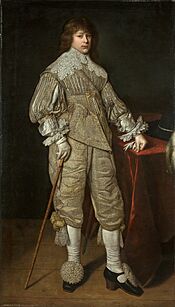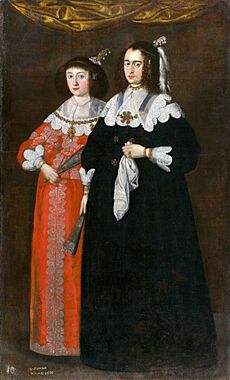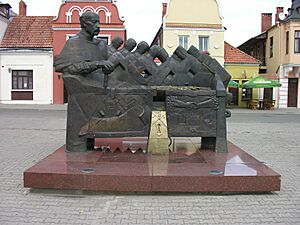Janusz Radziwiłł (1612–1655) facts for kids
Quick facts for kids
Prince
Janusz II Radziwiłł |
|
|---|---|
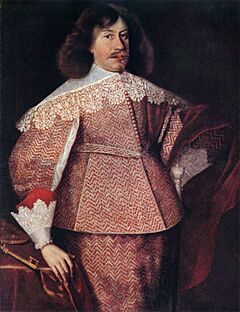 Portrait by Strobel 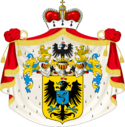 |
|
| Coat of arms | Trąby |
| Born | 2 December 1612 Papilys near Birże, Polish–Lithuanian Commonwealth |
| Died | 31 December 1655 (aged 43) Tykocin, Polish–Lithuanian Commonwealth |
| Buried | Kėdainiai |
| Noble family | Radziwiłł |
| Spouse(s) | Katarzyna Potocka Maria Lupu |
| Issue | with Katarzyna Potocka: Anna Maria Radziwiłł |
| Father | Krzysztof Radziwiłł |
| Mother | Anna Kiszka |
Prince Janusz Radziwiłł (born December 2, 1612 – died December 31, 1655) was a very powerful noble in the Polish–Lithuanian Commonwealth. This was a large country in Europe that existed from 1569 to 1795. Janusz Radziwiłł held many important jobs in the government. These included being the Court Chamberlain of Lithuania, Field Hetman of Lithuania, and later Grand Hetman of Lithuania. A Hetman was a top military commander. He was also a governor (called a voivode) of Vilna Voivodeship.
The Radziwiłł family was one of the wealthiest and most influential families in the Commonwealth. Over time, their goals sometimes differed from the country's goals. Janusz Radziwiłł became one of the most powerful people in the Grand Duchy of Lithuania, which was part of the Commonwealth. Some historians believe his actions contributed to the end of the Commonwealth's "Golden Age."
During a major war called the Deluge, when Sweden invaded the Commonwealth, Janusz Radziwiłł made a controversial choice. He decided to side with the Swedish king. He signed agreements like the Treaty of Kėdainiai and the Union of Kėdainiai. This decision made many other nobles, even some in his own family, angry. His forces were eventually defeated, and he died while his castle at Tykocin was under attack.
Contents
Early Life and Education
Janusz Radziwiłł was born on December 2, 1612, in a place called Papilys. He was born into the Radziwiłł family, one of the most important and rich noble families in the Polish–Lithuanian Commonwealth.
When he was 16, in September 1628, he went on a four-year trip. He traveled mainly in Germany and the Netherlands to get an education. He came back to Warsaw, the capital, in the autumn of 1632. Soon after, the new king, Władysław IV Vasa, sent him on a diplomatic mission. This mission was to the Netherlands and the United Kingdom.
As a reward for his work, he received his first government job in 1633. He became the Court Chamberlain of Lithuania. This was an important position in the royal court.
Early Military and Political Roles
In 1634, Janusz Radziwiłł took part in the Smolensk War. He mostly stayed with the king and did not fight in the main battles. For the next five years, he spent a lot of time at the royal court. He became a regular part of King Władysław IV Waza's group.
He also gained more titles. In 1635, he became the starost (a type of local administrator) of Kamieniec. In 1638, he became starost of Kazimierz Dolny. From 1636, he managed his family's large estates. He also attended most of the meetings of the Sejm, which was the Commonwealth's parliament.
Janusz Radziwiłł married Katarzyna Potocka on February 2, 1638. He was a Calvinist (a type of Protestant Christian), and she was Catholic. Their different religions did not cause big problems. They had three children, but only their daughter, Anna Maria, lived to be an adult. Katarzyna died in 1642. In 1645, Janusz married again to Maria Lupu. She was the daughter of a ruler from Moldavia.
Rising to Power

When his father died in 1641, Janusz Radziwiłł became one of the richest nobles in the entire Commonwealth. In 1646, he became a member of the Polish Senate. This was a very important group of advisors to the king. In April of that year, he also became the Field Hetman of Lithuania. This meant he was a top military commander. Later, in November, he received another important title: starost of Samogitia. In 1648, he was chosen for the Lithuanian Tribunal, a high court.
That same year, the Commonwealth faced two big problems. King Władysław died and was replaced by John II Casimir Vasa. Also, a major rebellion called the Khmelnytsky Uprising began. Janusz Radziwiłł led Commonwealth forces to victory in several battles. He won the Battle of Mazyr in February 1649 and the Battle of Loyew in July.
Fighting continued in 1651. Radziwiłł again led the Lithuanian forces to victory at the Second Battle of Loyew in July. His forces captured Kiev on August 4 and fought in the Battle of Bila Tserkva in September.
Challenges and New Titles
In 1652, a special rule called the liberum veto was used in the Sejm. This rule allowed any single member to stop a law or even end the entire parliament session. This happened, and the parliament was forced to close. Some historians think Janusz Radziwiłł might have been behind this, but there is no clear proof.
In 1653, the Cossacks, who were part of the rebellion, allied with Russia. Russian forces then invaded the Commonwealth from the east. In March of that year, Janusz became the governor (voivode) of Wilno. On June 17, 1654, Janusz was promoted from Field Hetman to Grand Hetman of Lithuania. This was the highest military rank in Lithuania.
Even with these promotions, his relationship with the king was getting worse. In August 1654, Janusz Radziwiłł defeated the invading Russians at the Battle of Shklow. This was his last victory. A few days later, he was defeated by the Russians at the Battle of Shepeleviche. The following winter, a Lithuanian counter-attack failed.
Alliance with Sweden
Janusz Radziwiłł's trust in the Polish side was deeply shaken during the Battle of Vilnius in 1655. As the Grand Hetman of Lithuania, he had to defend Vilnius, the capital of the Grand Duchy, from a large Russian army. The Russian army had at least 41,000 soldiers. Janusz Radziwiłł could only gather about 5,000 to 7,000 men.
The situation worsened when King John II Casimir Vasa ordered about 5,000 royal troops to retreat. This lowered the morale of the defenders. People in Vilnius began to leave the city quickly. Important treasures, like the coffin of Saint Casimir and valuable books, were moved out of the city for safety.
Janusz Radziwiłł set up defenses near the Neris river to protect the evacuation. The battle started on August 8, 1655, and lasted all day. The Lithuanians fought bravely and captured three Russian flags. That night, the Lithuanian army split up and retreated. The soldiers defending the Vilnius Castle Complex surrendered two days later. The Russian forces then looted the city and killed many people for several days. A fire also destroyed part of the city.
The Deluge and the Treaties
While the war with Russia was still going on, the Commonwealth faced a new threat. In June 1655, Swedish forces began to invade the northern parts of the Commonwealth. This Swedish invasion is known as the Deluge.
Janusz Radziwiłł and his cousin, Bogusław Radziwiłł, started talking with the Swedish king, Charles X Gustav of Sweden. They discussed how to change the Union of Lublin, which had created the Commonwealth. Janusz first declared the Grand Duchy of Lithuania a Swedish protectorate. This happened with the Treaty of Kėdainiai on August 17, 1655. Then, on October 20, the cousins signed another treaty. This created a Swedish-Lithuanian union. Under this agreement, the Radziwiłł family would rule a part of the Grand Duchy.
Janusz was not the only noble who considered other options. Many Polish nobles believed King John II Casimir was weak. They encouraged Charles Gustav to claim the Polish crown. John II Casimir had few friends among the Polish nobles. He openly favored Austria and seemed to disrespect the Commonwealth. Other regional governors also surrendered their lands to Charles Gustav.
However, King John II Casimir and his allies eventually regained power. This started with the resistance at Jasna Góra and the Tyszowce Confederation. The Swedish defeat and their retreat from the Commonwealth ended the plans of Janusz and Bogusław. Janusz Radziwiłł died in Tykocin. His castle was under attack by forces loyal to the Commonwealth.
Legacy and Remembrance
In Polish culture, Janusz Radziwiłł is often remembered negatively. This is mostly because of how he was shown in the famous book series The Trilogy by Henryk Sienkiewicz. Sienkiewicz, a Nobel Prize winner, portrayed Radziwiłł's alliance with the Swedes as a betrayal. He wrote about Radziwiłł's death: "Earthly ruin, a fallen soul, darkness, nothingness-that is all he managed to attain as a reward for service to himself."
However, in Lithuania, Janusz Radziwiłł (Jonušas Radvila) is remembered more positively. He is seen as an important supporter of the Lithuanian press and a defender of Lithuanian interests.
Janusz Radziwiłł is also shown as a character in the movie The Deluge by Jerzy Hoffman. He is played by the actor Władysław Hańcza.
Images for kids


